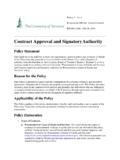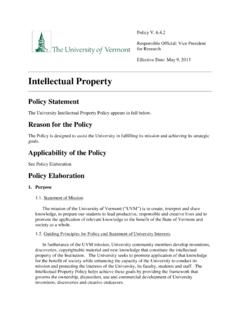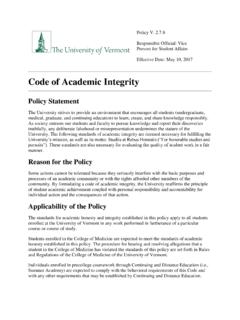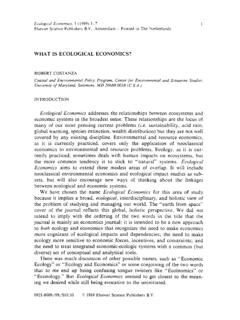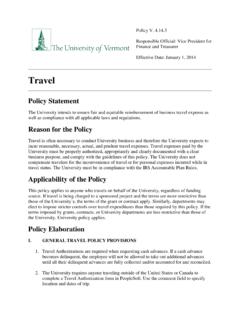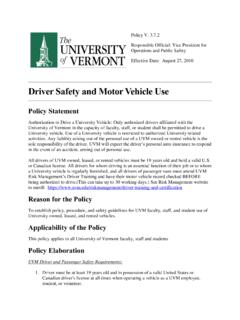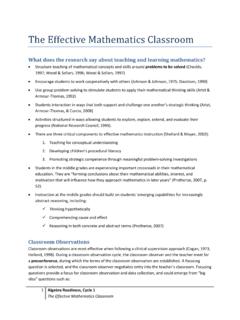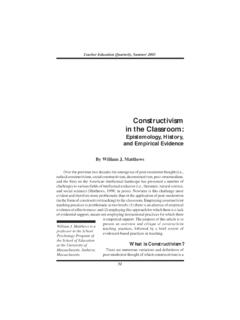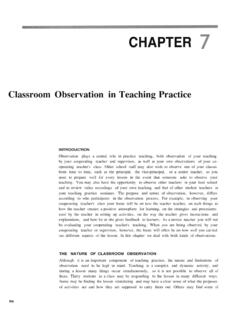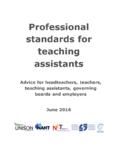Transcription of Changing Behaviors by Changing the Classroom Environment
1 behavior Matters Changing Behaviors by Changing the Classroom Environment Caroline A. Guardino and Elizabeth Fullerton What impact does the Classroom envi- ronment have on overall class behavior and learning? Many teachers face dis- ruptive behavior in their classrooms. How can they target and change prob- lem areas in the Classroom environ- ment? By collecting data on students'. engagement during instruction, disrup- tive behavior , and teacher observations, teachers can identify which physical aspects of their Classroom need to be improved. Changing the Classroom Environment can increase academic TEACHING Exceptional Children, Vol. 42, No. 6, pp. 8-13. Copyright 2010 CEC. engagement and decrease disruptive behavior . One challenge teachers face is disrup- tive behavior in their classrooms.
2 In a 2004 survey, 75% of teachers noted that they would spend more time teaching and teaching effectively if they had less disruptive behavior in their classrooms (Public Agenda, 2004). Disruptive behavior ( , speak- ing without permission, getting out of seat) often interferes with students'. engagement in the learning process. Another challenge for teachers is to find Classroom management strategies that are proactive, preventative, and relatively easy to implement, and which provide minimal disruption to the Classroom . 8 COUNCIL FOR EXCEPTIONAL CHILDREN. Figure 1. Steps to Changing the Classroom Environment What types of disruptive Behaviors occur in your Classroom ? When are the most disruptive Behaviors occurring? Time of day?
3 Under which type of circumstances? How are different areas of your Classroom utilized? Do the tasks completed in the areas change throughout the day? (Sometimes the library area is for reading but during math it is for group activities.). Observe Where is disruptive behavior occurring? Are students able to work at desks without distractions? Are students able to work in group areas without distractions from the surrounding Environment ? Provide areas of personal space (Hood-Smith & Leffingwell, 1983, Visser, 2001). Decrease or change placement of stimulating visuals. Clear pathways between students and high trafficked areas (Visser, 2001; Weinstein, 1979). Make a clear distinction between individual versus group activity areas. Rearrange teacher's desk (Proshansky & Wolfe, 1974; Zifferblatt, 1972).
4 Place barriers and/or partitions in the Classroom (Evans & Lovell, 1979; Gump, 1974;. Proshansky & Wolfe, 1974). Address acoustic quality in the Classroom by eliminating objects that produce background noise. Modify Modify Classroom climate by adjusting lighting, air flow, temperature. Organize areas by adding shelves, labels, or cubbies (Evans & Lovell, 1979; Weinstein, 1979). Rearrange student seating ( , coed dyads, rows) facing away from visual distractions such as doorways and windows. Alter the room to ensure a clear line of sight. Are you using the modifications correctly? Are you using the modifications consistently? Follow-Up Are the modifications being used how they were intended to be used? Do any modifications need rearranging, Changing , or removal?
5 Do you need to implement additional modifications? Researchers have investigated the 2002). Although the well-designed modifications are an essential part of relationship between the Classroom Classroom has proven benefits, there is Classroom management, many teach- Environment , student behavior , and little research on the impact environ- ers are not aware of the process of academic engagement (Hood-Smith & mental modifications have on behavior implementing them. Assessing the Leffingwell, 1983; Visser, 2001). A well- and learning (Guardino, 2009; Schilling Classroom Environment as to its organized Classroom permits more pos- & Schwartz, 2004). impact on student behavior and imple- itive interactions between teachers and Environmental modifications are a menting changes to that Environment children, reducing the probability that preventative, whole-class approach is a three-stage process (see Figure 1).
6 Challenging Behaviors will occur (Mar- (Emmer & Stough, 2001) that may The first step is for the teacher to tella, Nelson, & Marchand-Martella, decrease chronic behavior problems, observe the students within the class- 2003). Additionally, modifying the prevent behavior problems for stu- room Environment , noting where and Classroom Environment may serve as a dents who are at risk, and allow chil- when disruptive behavior is occurring direct intervention for children who dren with minimal or no problem and how different areas of the class- demonstrate ongoing disruptive behav- behavior to access learning without room are utilized. For example, are ior (Conroy, Davis, Fox, & Brown, interruption. Although environmental students unable to work without TEACHING EXCEPTIONAL CHILDREN JULY/AUG 2010 9.)
7 Figure 2. Ms. Thompson's Classroom : Before and After Environmental Changes distraction from peers and the environ- carrels (see Figure 2); if the outside Case Study: Ms. Thompson's ment? Are students interrupting the Environment causes distractions, desks Inclusive Classroom lesson because materials are unorgan- can be rearranged so students' desks ized and inaccessible? don't face the windows. If materials Ms. Thompson teaches at an elemen- After observation, the teacher are inaccessible, each student may tary school in an urban area of the should review possible options for need individual storage space ( , southeastern United States. Of the school's nearly 1,000 students, about 90% are eligible for free or reduced Are students unable to work without distraction from peers lunch.)
8 The school has failed to make and the Environment ? Are students interrupting the lesson annual yearly progress, as required by the No Child Left Behind Act of 2001, because materials are unorganized and inaccessible? for the past 6 years. In addition, according to state standards the school modifying problem areas in the class- chair bags, desks with compartments; has performed below average (receiv- room. Classroom space can be modi- see Figure 3). ing a D or F grade) the past 2 years. fied in a variety of ways (Bullard, 2010; After modifying the Classroom envi- Ms. Thompson's fourth-grade inclu- Guardino, 2008; Lawry, Danko, & ronment, teachers should self-critique sive Classroom had high levels of dis- Strain, 1999), including using the follow-up questions in Figure ruptive behavior : She would report 1.
9 When teachers ask themselves ques- disruptive Behaviors three or more Arranging Classroom furniture to times a week to school personnel. Of tions such as Are my students consis- define learning areas. the 17 students in her Classroom , one tently using desk carrels during indi- Improving accessibility and avail- vidual work time? or Do the students received special education services and ability of materials. have all the materials they need several students were awaiting referrals Delineating traffic patterns. throughout the day in their individual for special education assessment. The storage space? , they are able to under- students in the Classroom exhibited Improving organization of materials. stand what modifications are working high levels of disruptive behavior such For example, if students are distracted and if they need to implement addi- as calling out answers and profanities, by peers, the teacher could use desk tional changes.
10 Throwing objects, hitting, and pushing, 10 COUNCIL FOR EXCEPTIONAL CHILDREN. Figure 3. Examples of Possible Environmental Changes in the Classroom Note. Possible environmental changes in the Classroom include chair bags for personal belongings; modifying the computer area to reduce distractions; using shelving (in this case, a combined storage space and bookcase) to create separate group space areas; and setting the teacher's desk at an angle and adding shelves to increase personal space. as well as complete disregard for With Ms. Thompson's input, we teacher's request to sit down at his teacher direction or instruction. Several defined academic engagement as pur- desk and work on the assigned task. of the students received in-school and poseful attention such as raising a After the interview and establishing out-of-school suspensions during the hand, answering a question, working the data we needed to collect, we took duration of the study.

